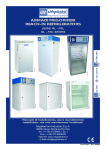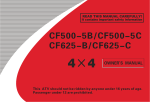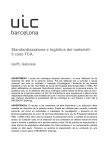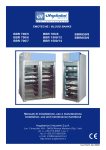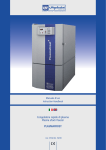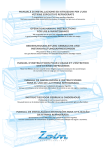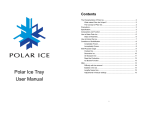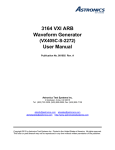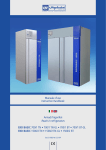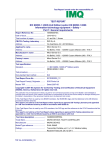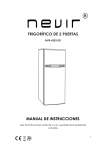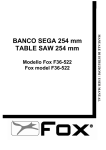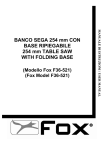Download Armadi frigoriferi Reach-in refrigerators FRL Manuale d`uso
Transcript
Manuale d’uso Instruction Handbook Armadi frigoriferi Reach-in refrigerators FRL Cod. 513417 Rel. 310108 464 Località Cimacolle 06056 Massa Martana (Pg) Italy AVVERTENZA IMPORTANTE I prodotti realizzati dal costruttore sono caratterizzati da un elevato contenuto tecnologico che talvolta richiede un adattamento tecnico di parti o componenti altrimenti reperibili sul mercato nella loro versione standard commerciale. Pertanto, la sostituzione di parti o componenti con altri non originali, ossia non forniti e garantiti direttamente dal COSTRUTTORE, nonché l’accertamento di interventi tecnici effettuati da personale non autorizzato, comporteranno l’immediata cessazione della garanzia, se in essere, e comunque di qualsiasi responsabilità nei confronti dell’acquirente e di terzi, da parte del COSTRUTTORE stesso. IMPORTANT WARNING The high level of technology of the products made by the manufacturer occasionally requires components to be adapted from parts normally found on the market in their standard commercial version. Therefore, if it should be ascertained that any parts have been replaced with other components that are not original, i.e. that have not been supplied and guaranteed directly by the MANUFACTURER, or that any unauthorised technical inter ventions have been carried out, the guarantee, if any is in force, shall be considered no longer valid and the MANUFACTURER himself shall no longer be held responsible towards the purchaser and towards third parties. AVVERTISSEMENT IMPORTANT Les produits réalisés par le constructeur sont caractérisés par un haut niveau technologique qui demande parfois une adaptation technique de parties ou de composants autrement disponibles sur le marché dans leur version commerciale standard. Pour cette raison, la substitution de parties ou composants par d’autres non originaux, c’est à dire non fournis et garantis directement par le CONSTRUCTEUR, ou bien la constatation que du personnel non autorisé a effectué des interventions techniques; auront pour conséquence l’immédiate cessation de la garantie en cours et de toute façon de toutes responsabilités du CONSTRUCTEUR vis à vis de l’acheteur ou de tierces parties. WICHTIGE WARNUNG Das hohe technische Niveau der Produkte des Herstellers erfordert teilweise Komponenten, die verändert werden müssen gegenüber handelsüblichen Produkten ; wie sie am Markt zu finden sind. Beim Austausch von Teilen oder Komponenten; die nicht dem Orginal entsprechen, das heißt nicht direkt vom HERSTELLER geliefert und garantiert wurden, bzw. daß technische Veränderungen durch nicht autorisiertes Personal vorgenommen wurde, gilt die Garantie, falls noch in Kraft, als erloschen und der HERSTELLER kann nicht mehr länger haftbar gemacht werden gegenüber dem Käufer und Dritten. AVISO IMPORTANTE Los productos elaborados por el fabricante se caracterizan por un alto nivel tecnológico y ocasionalmente requieren adaptaciones técnicas de partes o componentes que normalmente se encuentran en el mercado en su versión comercial estándar. Por tanto, la sustitución de partes o componentes, por otros que no sean originales, es decir no suministrados y garantizados por el FABRICANTE, o bien se constata la intervención técnica por de personal no autorizado, supondrá el cese inmediato de la garantía, si está en vigor, así como de cualquier otra responsabilidad del FABRICANTE de cara tanto al comprador como a terceras personas. I 1 2 3 4 5 6 7 8 9 10 11 12 13 14 GB SUMMARY SOMMARIO RIEPILOGO DEI DATI DI MARCATURA.........................................................2 AVVERTENZE . ............................................................................................3 2.1 AVVERTENZE GENERALI......................................................................3 2.2 AVVERTENZE PER IL TRASPORTO E LA MOVIMENTAZIONE...........4 2.3 AVVERTENZE PER L’INSTALLAZIONE.................................................4 2.4 AVVERTENZE PER IL PERSONALE ADDETTO....................................4 2.5 AVVERTENZE PER LA MANUTENZIONE..............................................5 2.6 SPIEGAZIONE DEI SIMBOLI..................................................................5 CARATTERISTICHE TECNICHE.....................................................................6 3.1 DATI TECNICI . .......................................................................................6 3.2 FUSIBILI . ............................................................................................8 3.3 CONDIZIONI AMBIENTALI......................................................................8 MOVIMENTAZIONE E DISIMBALLO...............................................................9 4.1 REQUISITI DEL PERSONALE................................................................9 4.2 STATO DELLA MACCHINA.....................................................................9 4.3 MEZZI NECESSARI PER LA MOVIMENTAZIONE.................................9 4.4 DISIMBALLO..........................................................................................10 4.5 IMMOBILIZZAZIONE DELLA MACCHINA.............................................11 DESCRIZIONE DEL SISTEMA.......................................................................12 5.1 VISTA GENERALE ...............................................................................12 5.2 VISTA POSTERIORE............................................................................13 5.3 VISTA INTERNA....................................................................................14 5.4 SISTEMA DI CONTROLLO....................................................................15 5.4.1 Modello FRL180........................................................................15 5.4.2 Tutti i modelli (escluso mod. FRL180).......................................16 5.5 SISTEMA REFRIGERANTE..................................................................17 5.6 FUNZIONAMENTO DEL CIRCUITO DI RAFFREDDAMENTO.............17 5.7 STRUTTURA..........................................................................................17 5.8 FUNZIONAMENTO DEL CIRCUITO ELETTRICO.................................17 INSTALLAZIONE............................................................................................18 6.1 POSA DELLA MACCHINA.....................................................................18 6.1.1 Montaggio maniglia...................................................................18 6.2 COLLEGAMENTO ELETTRICO............................................................19 6.2.1 Collegamento elettrico alla rete.................................................19 6.2.2 Sostituzione del cavo di alimentazione (senza pannello aggiuntivo).................................................................................19 6.2.3 Sostituzione del cavo di alimentazione (con pannello aggiuntivo).................................................................................20 6.2.4 Collegamento allarme remoto (se presente pannello aggiuntivo).................................................................................20 USO PREVISTO DAL FABBRICANTE..........................................................21 7.1 SCOPO DELLE MACCHINE..................................................................21 7.2 DESTINAZIONE DELLE MACCHINE....................................................21 7.3 OPERATORE.........................................................................................21 7.4 LIMITAZIONI D’USO..............................................................................21 7.5 RISCHI RESIDUI....................................................................................21 AVVIAMENTO . ..........................................................................................22 8.1 avviamento (tutti i modelli)................................................................22 8.2 impostare la temperatura.........................................................22 8.2.1 Modello FRL180........................................................................22 8.2.2 Tutti i modelli (escluso mod. FRL180).......................................23 8.3 DESCRIZIONE DEL PANNELLO COMANDI AGGIUNTIVO.................24 8.3.1 Sistema di allarme.....................................................................25 8.3.2 Regolazione della temperatura di soglia del sistema di allarme26 8.3.3 Arresto.......................................................................................26 8.4 ALCUNE PRECAUZIONI.......................................................................26 USO . ..........................................................................................27 9.1 INDICAZIONI PER IL RAFFREDDAMENTO.........................................27 9.2 REGISTRATORE GRAFICO DI TEMPERATURA.................................27 9.2.1 Uso del registratore...................................................................28 ORGANI DI SICUREZZA-VERIFICA E TARATURA......................................30 MANUTENZIONE............................................................................................30 11.1 CONTROLLO DEL SISTEMA DI ALLARME (Opzionale)......................30 11.2 SBRINAMENTO.....................................................................................30 11.3 PULIZIA DELLA STRUTTURA...............................................................31 11.3.1 Pulizia delle guarnizioni.............................................................31 11.3.2 Pulizia del condensatore...........................................................31 11.4 MANUTENZIONE DEL SISTEMA DI RAFFREDDAMENTO.................31 11.5 MANUTENZIONE PARTE ELETTRICA-ELETTRONICA.......................31 11.6 SOSTITUZIONE BATTERIA INDICATORE DI TEMPERATURA..........32 11.6.1 Mod. FRL180.............................................................................32 11.6.2 Tutti i modelli (escluso mod. FRL180).......................................33 11.7 SOSTITUZIONE LAMPADA (solo mod. GL)..........................................34 INCONVENIENTI E RIMEDI...........................................................................35 DISINSTALLAZIONE......................................................................................36 13.1 MESSA FUORI SERVIZIO.....................................................................36 13.2 ROTTAMAZIONE...................................................................................36 SCHEMI . ..........................................................................................37 14.1 SCHEMA FRIGORIFERO......................................................................37 14.2 SCHEMA ELETTRICO (senza pannello aggiuntivo) - solo FRL180............ 38 14.3 SCHEMA ELETTRICO (con pannello aggiuntivo)- solo FRL180............39 14.4 SCHEMA ELETTRICO (senza pannello aggiuntivo) - altri mod. FRL.......... 40 14.5 SCHEMA ELETTRICO (con pannello aggiuntivo)- altri mod. FRL..........41 1 2 3 4 5 6 7 8 9 10 11 12 13 13 14 SUMMARY OF RATING PLATE DATA...........................................................2 WARNINGS ...........................................................................................3 2.1 GENERAL WARNINGS...........................................................................3 2.2 WARNINGS FOR TRANSPORT AND HANDLING..................................4 2.3 WARNINGS FOR INSTALLATION..........................................................4 2.4 WARNINGS FOR PERSONNEL IN CHARGE OF THE MACHINE.........4 2.5 WARNINGS FOR MAINTENANCE..........................................................5 2.6 EXPLANATION OF SYMBOLS................................................................5 TECHNICAL SPECIFICATIONS.......................................................................7 3.1 TECHNICAL DATA..................................................................................7 3.2 FUSES ...........................................................................................8 3.3 ENVIRONMENTAL CONDITIONS...........................................................8 HANDLING AND REMOVAL OF PACKAGING...............................................9 4.1 PERSONNEL REQUISITES....................................................................9 4.2 MACHINE CONDITIONS.........................................................................9 4.3 EQUIPMENT NEEDED FOR HANDLING................................................9 4.4 REMOVAL OF PACKAGING.................................................................10 4.5 HOW TO BLOCK THE MACHINE . .......................................................11 DESCRIPTION OF THE SYSTEM..................................................................12 5.1 GENERAL VIEW ...................................................................................12 5.2 REAR VIEW .........................................................................................13 5.3 INTERNAL VIEW...................................................................................14 5.4 CONTROL SYSTEM..............................................................................15 5.4.1 FRL180 model...........................................................................15 5.4.1 All models (with the exception of mod. FRL180).......................16 5.5 COOLING SYSTEM...............................................................................17 5.6 FUNCTIONING OF THE COOLING SYSTEM.......................................17 5.7 STRUCTURE.........................................................................................17 5.8 FUNCTIONING OF THE ELECTRIC SYSTEM . ...................................17 INSTALLATION .........................................................................................18 6.1 POSITIONING OF THE MACHINE........................................................18 6.1.1 Handle assembly ......................................................................18 6.2 ELECTRICAL WIRING...........................................................................19 6.2.1 How to connect to the electrical mains supply...........................19 6.2.2 Replacement of the supply cable (without additional panel)........19 6.2.3 Replacement of the supply cable (with additional panel)..........20 6.2.4 Remote alarm (only with additional panel)................................20 USE FORESEEN BY THE MANUFACTURER...............................................21 7.1 AIM OF THE MACHINES.......................................................................21 7.2 INTENDED USE OF THE MACHINES..................................................21 7.3 OPERATOR .........................................................................................21 7.4 USE LIMITS .........................................................................................21 7.5 USE OF PROTECTIVE CLOTHING......................................................21 START-UP .........................................................................................22 8.1 SWITCHING ON (all models).................................................................22 8.2 SETTING THE temperature...........................................................22 8.2.1 FRL180 model...........................................................................22 8.2.2 All models (with the exception of mod. FRL180).......................23 8.3 DESCRIPTION OF ADDITIONAL PANEL.............................................24 8.3.1 Alarm system.............................................................................25 8.3.2 Adjustment of alarm system temperature threshold..................26 8.3.3 Turning off.................................................................................26 8.4 SOME PRECAUTIONS..........................................................................26 USE .........................................................................................27 9.1 INSTRUCTIONS FOR COOLING..........................................................27 9.2 TEMPERATURE CHART RECORDER.................................................27 9.2.1 Use of the recorder....................................................................28 SAFETY DEVICES- CHECK AND SET-UP....................................................30 MAINTENANCE .........................................................................................30 11.1 ALARM SYSTEM CONTROL (Optional)................................................30 11.2 DEFROSTING........................................................................................30 11.3 HOW TO CLEAN THE STRUCTURE....................................................31 11.3.1 How to clean the gaskets..........................................................31 11.3.2 How to clean the condenser......................................................31 11.4 COOLING SYSTEM MAINTENANCE....................................................31 11.5 MAINTENANCE OF THE ELECTRICAL-ELECTRONIC PART.............31 11.6 TEMPERATURE DISPLAY BATTERY REPLACEMENT .....................32 11.6.1 FRL180 model...........................................................................32 11.6.2 All models (with the exception of mod. FRL180).......................33 11.7 HOW TO REPLACE THE LAMP (GL model only).................................34 TROUBLESHOOTING....................................................................................35 REMOVAL FROM INSTALLATION SITE.......................................................36 13.1 DISASSEMBLY......................................................................................36 13.2 SCRAPPING..........................................................................................36 DISINSTALLAZIONE......................................................................................36 DIAGRAMS .........................................................................................37 14.1 REFRIGERATOR DRAWING................................................................37 14.2 ELECTRIC DRAWING WITHOUT ADDITIONAL PANEL - FRL180 model only .........................................................................................38 14.3 ELECTRIC DRAWING WITH ADDITIONAL PANEL - FRL180 model only... 39 14.4 ELECTRIC DRAWING WITHOUT ADDITIONAL PANEL - other FRL models .............................................................................................. 40 14.5 ELECTRIC DRAWING WITH ADDITIONAL PANEL - other FRL models... 41 513417 2 1 3 4 8 5 6 9 7 13 10 12 11 14 17 15 16 18 1 RIEPILOGO DEI DATI DI MARCATURA I • Localizzate la targa apposta alla macchina per rilevare i dati tecnici. • Verificate il modello della macchina e la tensione di alimentazione prima di compiere qualsiasi operazione. • Se rilevate delle discordanze contattate suabito il produttore o l’azienda che ha effettuato la fornitura. 1 2 3 4 5 6 7 8 9 10 11 12 13 14 15-16 17-18 Marchio di conformità CE Marchio e indirizzo del fabbricante Modello Numero di serie Anno di costruzione Temperatura Umidità relativa Peso Grado di protezione elettrica Tensione di alimentazione Potenza assorbita Assorbimento elettrico Frequenza Classe di isolamento Tipo di refrigerante Pressione refrigerante GB 1 SUMMARY OF RATING PLATE DATA • Find the special rating plate on the machine in order to check the technical data. • Check the machine model and supply voltage before carrying out any operation whatsoever. • If you find any discrepancies, contact the manufacturer or your supplier immediately. 1 2 3 4 5 6 7 8 9 513417 10 11 12 13 14 15-16 17-18 EC compliancy mark Manufacturer’s address Model Serial N° Year of manufacture Temperature Relative humidity Weight Electrical protection grade Supply voltage Absorbed power Electrical absorption Frequency Isolation class Type of refrigerant Pressure of refrigerant I 2.1 2 AVVERTENZE AVVERTENZE GENERALI Se necessario fotocopiate le pagine che destinerete all’uso diretto sulla macchina. Il manuale deve avere una durata almeno pari a quella della macchina. • Il manuale di istruzioni rispecchia la tecnica al momento della costruzione della macchina; il produttore si riserva il diritto di apportare tutte le modifiche ritenute opportune, alle macchine e ai manuali di istruzione, senza obbligo di preavviso o di sostituzione. In caso di smarrimento o distruzione del manuale è possibile richiederne una copia apponendo, nella richiesta, i dati di marcatura (vedi cap1). • Non effettuate operazioni o manovre se non siete assolutamente certi del loro effetto; in caso di dubbio contattate il servizio di assistenza tecnico più vicino o direttamente il produttore. • Il produttore si ritiene sollevato da ogni responsabilità per danni causati alla macchina o alle cose nei casi seguenti: - uso improprio della macchina - impiego di personale non idoneo - montaggio e installazione non corretti - difetti negli impianti - modifiche o interventi non autorizzati alla macchina - utilizzo di parti di ricambio non originali - inosservanza delle norme dettate nel presente manuale - eventi eccezionali • Il presente manuale di istruzioni si rivolge ai seguenti soggetti: - Addetti del trasporto, movimentazione e disimballo - Addetti alla preparazione degli impianti e del sito di installazione - Installatori - Addetti all’uso della macchina - Addetti alla manutenzione • Il manuale di istruzioni indica l’utilizzo previsto dal fabbricante e non può mai sostituire un’adeguata esperienza dell’operatore, può costituire solo un promemoria delle principali operazioni da svolgere. • Il manuale di istruzioni deve essere conservato con la massima cura e reso sempre disponibile per la consultazione. GB 2.1 La presente macchina non è contemplata nell’allegato IV delle normative comunitarie sulle macchine, pertanto è applicata la procedura di cui all’articolo 8, paragrafo 2, lettera A, delle normative comunitarie sulle macchine 89/392/CEE e 91/368/CEE. L’articolo 8, paragrafo 2, lettera A delle normative comunitarie sulle macchine 89/392/CEE e 91/368/CEE obbliga il costruttore a realizzare il fascicolo previsto dall’allegato delle sopracitate leggi, realizzato e conservato nell’archivio tecnico della ditta Angelantoni Industrie, località Cimacolle, Massa Martana (Perugia). 2 WARNINGS GENERAL WARNINGS The handbook should last at least the life-time of the machine itself. • The instruction handbook gives technical information on how the machine is manufactured at the present time; the manufacturer reserves the right to carry out any modifications he deems necessary to the machines and to the instruction handbooks, without prior notice or replacement. If you lose or destroy the handbook, you may ask for a copy. Please give the rating plate data (see chap. 1) in your request. • Do not carry out any operations or manoeuvres unless you are absolutely certain of their effect; if in doubt, contact your nearest technical assistance service or the manufacturer himself. • The manufacturer will not be held responsible for damage to the machine or to objects in the following cases: - improper use of the machine - use of unsuitable personnel - incorrect assembly and installation - defects in the plant systems - unauthorized modifications or operations to the machine - use of spare parts that are not original pieces - failure to comply with the norms given in this handbook - exceptional events • This instruction handbook has been designed for the following personnel: - Personnel in charge of transport, handling and removal of packaging - Personnel in charge of the preparation of the plant systems and installation site - Installers - Personnel in charge of using the machine - Personnel in charge of maintenance • The instruction handbook indicates the use foreseen by the manufacturer and cannot ever replace adequate experience of the operator. It can only be used as a reminder of the main operations to be carried out. • The instruction handbook should be kept carefully and should also be within easy reach for reference. If necessary, photocopy the pages concerned directly with machine use. This machine is not referred to in enclosure IV of the community norm on machines, and therefore the procedure in article 8, paragraph 2, letter A in the Community norms for machines 89/392/CEE and 91/368/EEC has been applied. Article 8, paragraph 2, letter A of the Community norms for machines 89/392/CEE and 91/368/EEC obliges the manufacturer to provide the file foreseen by the enclosure of the afore-mentioned laws, and to store it in the technical archives of the company Angelantoni Industrie, località Cimacolle, Massa Martana (Perugia). 513417 I 2.2 2 AVVERTENZE AVVERTENZE PER IL TRASPORTO E LA MOVIMENTAZIONE • Questo simbolo, apposto su ciascun imballo indica il peso di ogni collo. Occorre sempre verificare che gli attrezzi e le macchine atte alla movimentazione e trasporto siano adeguate. • Mantenete sempre la macchina in posizione verticale. Se accidentalmente la macchina è stata capovolta o coricata non avviatela ma ponetela in posizione corretta e contattate il produttore. 2.3 AVVERTENZE PER L’INSTALLAZIONE • L’installazione deve essere effettuata da personale specializzato. • Occorre eseguire scrupolosamente le procedure per la realizzazione degli impianti prima di installare la macchina. • In fase di predisposizione del sito di installazione tenete conto dello spazio e delle condizioni di lavoro del personale addetto in modo da ridurre al massimo la rumorosità, l’affaticamento, il disagio e quant’altro possa influire negativamente sulle persone. • Nel prevedere il luogo di installazione tenete conto di lasciare sufficiente spazio per il controllo, la manutenzione, la pulizia e l’asporto dei residui di materiale scarto di lavorazione. • Provvedete ad illuminare adeguatamente il posto di lavoro in modo che il personale addetto si trovi nelle migliori condizioni operative. • Nel definire il punto di installazione riferitevi alle normative vigenti e in particolare: - attuate tutti i dispositivi antincendio e di sicurezza. 2.4 AVVERTENZE PER IL PERSONALE ADDETTO • La macchina può essere utilizzata solo da parte di personale che abbia preso completa visione delle norme descritte nel presente manuale. • L’apertura della camera a temperature molto diverse da quelle ambientali può causare inconvenienti:se la temperatura interna è molto bassa possono generarsi fenomeni di condensa e brinatura a causa dell’umidità ambiente. Frequenti aperture della porta in queste condizioni potranno generare ostruzione degli scambiatori termici. GB 2.2 2 WARNINGS WARNINGS FOR TRANSPORT AND HANDLING • This symbol, placed on each packaging, indicates the weight of each package. Always check that the tools and machines to handle and transport the machine are adequate. • Always keep the machine in an upright position. If the machine should accidentally turn upside-down or on its side, do not switch it on. Put it in the correct position and contact the manufacturer. 2.3 WARNINGS FOR INSTALLATION • Installation should always be carried out by specialized personnel. • Carefully follow the instructions on how to prepare the plant systems before installing the machine. • When the installation site is being prepared, bear in mind the space and work conditions of the personnel in charge of the machine so as to reduce to a minimum noise, fatigue, discomfort and anything else which may have a negative influence on the staff. • When designing the installation site, remember to leave sufficient space for control, maintenance, cleaning, and removal of production waste material. • Make sure that the work site is adequately lit so that personnel can work in optimum conditions. • When designing the installation site, please refer to the norms in force and in particular: - set up all the firefighting and safety devices. 2.4 WARNINGS FOR PERSONNEL IN CHARGE OF THE MACHINE • The machine may only be used by personnel who have read the rules described in this handbook. • To open the chamber when its temperature is very different from the ambient temperature could cause problems: if the internal temperature is very low, condensate and frosting could be caused by ambient humidity. If the door is often opened under these conditions, the heat exchangers could be obstructed. 513417 1 I 2.5 2 3 2 AVVERTENZE AVVERTENZE PER LA MANUTENZIONE • Scollegate sempre la macchina dalla rete elettrica prima di effettuare qualsiasi operazione di manutenzione. • Per la pulizia delle parti verniciate non utilizzate solventi o alcool in quanto tali prodotti possono danneggiare le superfici. 2.6 SPIEGAZIONE DEI SIMBOLI • I simboli mostrati possono trovarsi sulla macchina o all’interno del presente manuale di istruzioni. • Ponete attenzione al loro significato prima di procedere. GB 2.5 1 Uso di guanti. 2 Pericolo genericO Questo simbolo è sempre accompagnato dalla spiegazione del pericolo. 3 Attenzione! Nota importante. 4 Operazioni che devono essere compiute da almeno due persone. 1 Use gloves. 2 GENERAL DANGER This symbol is always accompanied by an explanation of the danger. 3 WARNING! Important note. 4 Operations that must be carried out by at least two people. 2 WARNINGS WARNINGS FOR MAINTENANCE • Always disconnect the machine from the electrical mains before carrying out any maintenance operation. • Do not use solvents or alcohol to clean the varnished parts as these products could damage the surface. 2.6 4 EXPLANATION OF SYMBOLS • The symbols shown below may be found on the machine or in this instruction handbook. • Pay attention to their meaning before going any further. 513417 I 3.1 3 CARATTERISTICHE TECNICHE DATI TECNICI FRL 180V Modelli FRL 180V -GL FRL 260V FRL 260V -GL Dimensione esterne(3) (L x P x H) (mm) 600 x 585 x 895 600 x 585 x 895 600 x 610 x 1250 600 x 610 x 1250 Dimensione interne (L x P x H) (mm) 550 x 450 x 750 550 x 450 x 750 470 x 440 x 1062 470 x 440 x 1062 160 160 240 240 +2 ÷ 12 +2 ÷ 12 +2 ÷ 14 +2 ÷ 14 Precisione temp. nello spazio(1) (IEC 68) (±°C) 1,5 1,5 1,5 1,5 Precisione temp. nel tempo (IEC 68) 1,5 1,5 1,5 1,5 R134a - R600a R134a - R600a R134a - R600a Volume utile (l) Campo di temperatura (°C) (1) (± °C) Gas refrigerante (2) R134a - R600a (110) 230 V (+6/-10 %) / 50 (60) Hz / 1 + T 4 Alimentazione elettrica Corrente massima assorbita (4) (A) 0,8 1,2 0,8 1,5 (kW/24h) 0,8 1 0,8 1 dB(A) 43 43 43 43 (kcal/h) 70 85 80 85 Peso netto con accessori in dotazione (kg) 47 54 54 67 Peso netto + pannello aggiuntivo (kg) 51 58 58 71 Peso con imballo in cartone + pedana (kg) 55 62 62 75 FRL 360V -GL FRL 500V FRL 500V -GL Consumo energetico Rumorosità Dissipazione termica FRL 360V Modelli Dimensione esterne(3) (L x P x H) (mm) 600 x 610 x 1640 600 x 610 x 1640 750 x 730 x 1640 750 x 730 x 1640 Dimensione interne (L x P x H) (mm) 470 x 440 x 1452 470 x 440 x 1452 590 x 560 x 1452 590 x 560 x 1452 340 340 520 520 +2 ÷ 14 +2 ÷ 14 +2 ÷ 14 +2 ÷ 14 Precisione temp. nello spazio (IEC 68) (±°C) 1,5 1,5 1,5 1,5 Precisione temp. nel tempo (IEC 68) 1,5 1,5 1,5 1,5 R134a - R600a R134a - R600a R134a - R600a Volume utile (l) Campo di temperatura (°C) (1) (1) (± °C) Gas refrigerante (2) R134a - R600a (110) 230 V (+6/-10 %) / 50 (60) Hz / 1 + T 4 Alimentazione elettrica Corrente massima assorbita (4) (A) 0,8 1,5 1,5 1,5 (kW/24h) 0,8 1,1 1,1 2 dB(A) 43 43 43 43 (kcal/h) 85 90 85 90 Peso netto con accessori in dotazione (kg) 64 82 78 97 Peso netto + pannello aggiuntivo (kg) 68 86 82 101 Peso con imballo in cartone + pedana (kg) 72 90 86 105 Consumo energetico Rumorosità Dissipazione termica (1) La prova è effettuata collegando le termocoppie (tipo T) ad una massa avente le seguenti caratteristiche: - materiale: lega di alluminio; - capacità termica: 102 J/K; - superficie esterna: 0,009 m2. Sono posizionate ad una distanza di L/10 dalle pareti della camera (L= lunghezza del lato della camera), secondo IEC 60068-3-5. - Fluttuazione di temperatura nel tempo: massima deviazione fra il valore massimo e minimo misurato da ciascuna sonda (valore di riferimento = valore medio nel punto considerato). - Variazione di temperatura nello spazio: massima deviazione fra i valori medi misurati dalle 9 sonde (valore di riferimento = valore di set-point). (2) Per il tipo di gas refrigerante vedere targa dati. (3) Per le apparecchiature con pannello aggiuntivo (P) l’altezza del congelatore aumenta di 175 mm per i modelli FRL 180 V / FRL 180 V-GL e 220 mm per gli altri modelli. (4) Vedi dati di targa. 513417 GB 3.1 3 TECHNICAL SPECIFICATIONS TECHNICAL DATA FRL 180V Models FRL 180V -GL FRL 260V FRL 260V -GL External dimensions(3) (W x D x H) (mm) 600 x 585 x 895 600 x 585 x 895 600 x 610 x 1250 600 x 610 x 1250 Internal dimensions (W x D x H) (mm) 550 x 450 x 750 550 x 450 x 750 470 x 440 x 1062 470 x 440 x 1062 160 160 240 240 +2 ÷ 12 +2 ÷ 12 +2 ÷ 14 +2 ÷ 14 Temperature accuracy in space(1) (IEC 68)(±°C) 1,5 1,5 1,5 1,5 Temperature accuracy in time (IEC 68) (± °C) 1,5 1,5 1,5 1,5 R134a - R600a R134a - R600a R134a - R600a Useful volume (l) Temperature range (°C) (1) Refrigerant gas (2) R134a - R600a (110) 230 V (+6/-10 %) / 50 (60) Hz / 1 + G 4 Electrical input Maximum absorbed current (4) (A) 0,8 1,2 0,8 1,5 (kW/24h) 0,8 1 0,8 1 dB(A) 43 43 43 43 (kcal/h) 70 85 80 85 Net weight with standard accessories (kg) 47 54 54 67 Net weight with additional panel (kg) 51 58 58 71 Weight with cardboard packaging + board (kg) 55 62 62 75 FRL 360V -GL FRL 500V FRL 500V -GL Energy consumption Noise level Thermal dissipation FRL 360V Models External dimensions(3) (W x D x H) (mm) 600 x 610 x 1640 600 x 610 x 1640 750 x 730 x 1640 750 x 730 x 1640 Internal dimensions (W x D x H) (mm) 470 x 440 x 1452 470 x 440 x 1452 590 x 560 x 1452 590 x 560 x 1452 340 340 520 520 +2 ÷ 14 +2 ÷ 14 +2 ÷ 14 +2 ÷ 14 Temperature accuracy in space (IEC 68)(±°C) 1,5 1,5 1,5 1,5 Temperature accuracy in time (IEC 68) (± °C) 1,5 1,5 1,5 1,5 R134a - R600a R134a - R600a R134a - R600a Useful volume (l) Temperature range (°C) (1) (1) Refrigerant gas (2) R134a - R600a (110) 230 V (+6/-10 %) / 50 (60) Hz / 1 + G 4 Electrical input Maximum absorbed current (4) (A) 0,8 1,5 1,5 1,5 (kW/24h) 0,8 1,1 1,1 2 dB(A) 43 43 43 43 (kcal/h) 85 90 85 90 Net weight with standard accessories (kg) 64 82 78 97 Net weight with additional panel (kg) 68 86 82 101 Weight with cardboard packaging + board (kg) 72 90 86 105 Energy consumption Noise level Thermal dissipation (1) The test is carried out by connecting the thermal couplings (type T) to a mass with the following characteristics: - material: aluminium alloy; - thermal capacity: 102 J/K; - external surface: 0.009 m2. They are positioned at a distance of L/10 from the room walls (L = length of room side), according to IEC 60068-3-5. - Temperature fluctuations over time: maximum difference between the lowest and highest value measured by each sensor (reference value= mean value at the point under study). - Temperature variations inside the space: maximum difference between the mean values measured by the 9 sensors (reference value = set-point value). (2) For the type of refrigerant, see the rating plate. (3) For appliances with the additional panel (P) the freezer height increases by 175 mm for FRL180 V / FRL180 V-GL models and 220 mm for other models. (4) See rating plate data. 513417 3.1 20 °C 35 °C PO1207-130 I 3.2 PO1207-140 3 CARATTERISTICHE TECNICHE FUSIBILI TUTTI I MODELLI (con pannello aggiuntivo) 3.3 3.2 FUSE 6A TT min.(*): +10 °C max.: + 30 °C max.: 80 % (*)La temperatura ambiente non deve essere inferiore al set point impostato. 3 TECHNICAL SPECIFICATIONS FUSES Symbol Value Code FUSE 6A TT ENVIRONMENTAL CONDITIONS In order for the appliance to operate correctly, it should be placed in a site with the following requisites: • far from heat sources, • far from direct sunlight, • far from air conditioning systems, • in a dust-free ambient. 513417 Codice Temperatura ambiente Umidità relativa UR ALL MODELS (with additional panel) 3.3 Valore CONDIZIONI AMBIENTALI Per il corretto funzionamento dell’apparecchiatura è necessario che il posizionamento rispetti i seguenti requisiti: • lontano da fonti di calore, • lontano dai raggi diretti del sole, • lontano dai sistemi di condizionamento, • ambiente non polveroso. GB Simbolo Ambient temperature Relative humidity RH min.(*): +10 °C max.: + 30 °C max.: 80 % (*)The ambient temperature must not be inferior to the chosen set-point. 4.1 4.2 kg A kg B 121199 mod 121199 mod KR1809-100 I 4.1 KR1809-200 4 MOVIMENTAZIONE E DISIMBALLO REQUISITI DEL PERSONALE Per la movimentazione della macchina non sono richiesti particolari requisiti da parte del personale addetto allo scopo (tenere presente la tipologia dell’imballo). Si raccomanda comunque di far effettuare tale operazione a chi abitualmente utilizza mezzi di sollevamento e trasporto. Si raccomanda, nonostante la semplicità dell’operazione, di verificare la corretta equilibratura del carico. SOLLEVAMENTO E MOVIMENTAZIONE CON CARRELLO ELEVATORE - MACCHINA PALLETTIZZATA Si raccomanda di posizionare correttamente le forche del muletto onde evitare di danneggiare la macchina. In ogni caso sarà cura 4.2 STATO DELLA MACCHINA dell’addetto alla movimentazione evitare danni alla struttura La macchina viene fornita normalmente imballata e pallettizzata. esterna durante tale operazione. Nel caso di consegna da parte di nostro personale la macchina Assicuratevi che le forche non urtino il telaio della macchina. può anche essere priva di imballo. Altri tipi di imballo possono Non impiegate il carrello elevatore se la macchina non è paletessere forniti in base alla destinazione e/o esigenze del cliente 4.3 tizzata. In caso di urto accidentale controllate immediatamente eventuali danni, se è il caso contattare il costruttore. MEZZI NECESSARI PER LA MOVIMENTAZIONE La macchina può essere sollevata e movimentata con carrello elevatore, carroponte, gru o altro mezzo idoneo avente una portata adeguata. SOLLEVAMENTO E MOVIMENTAZIONE CON CARROPONTE Accessori: cinghie in fibra tessile ed angolari in PVC. Peso: vedere dati tecnici. Movimentare la macchina solo con mezzi idonei (carrello elevatore ecc.). L’apposito bancale in legno, munito di sedi forcolabili, permette lo spostamento utilizzando gli usuali mezzi di movimentazione e di sollevamento. A Imballo in legno B Imballo in cartone Non imbracate la macchina con funi metalliche o catene in quanto possono danneggiarla. Non imbracare mai la macchina senza pallet. Al fine di evitare che l’olio contenuto nel compressore defluisca nel circuito refrigerante, trasportate, immagazzinate e movimentate l’apparecchiatura esclusivamente in posizione verticale, rispettando le indicazioni poste sull’imballo. Se la macchina viene coricata lasciatela in posizione verticale per almeno 24 ore prima di metterla in funzione. GB 4.1 4 HANDLING AND REMOVAL OF PACKAGING PERSONNEL REQUISITES HOW TO USE A LIFT TRUCK TO RAISE AND TRANSPORT PALLETIZED MACHINE Personnel in charge of handling the machine need no special requisites (just remember the type of packaging). However, we suggest that this is done by someone who is accustomed to using machines for lifting and transport operations. 4.2 Take care to position the lift truck forks correctly so as not to damage the machine. The person in charge of handling will be responsible for avoiding damage to the external structure during this operation. MACHINE CONDITIONS The machine is normally supplied packed and on a pallet. If the machine is delivered by our staff, it may be without packaging. Other types of packaging may be supplied according to the destination and/or customer’s needs. 4.3 Make sure that the forks do not hit the machine frame. Do not use a lift truck if the machine is not palletized. In case of accidental bumps, please check if there is any damage and if necessary, contact the manufacturer. EQUIPMENT NEEDED FOR HANDLING The machine can be raised and moved by a lift truck, bridge crane, crane or other suitable means with an adequate capacity. HOW TO USE A BRIDGE CRANE TO RAISE AND TRANSPORT THE MACHINE Only use suitable means (lift truck etc.) to handle the machine. The special wooden pallet equipped with fork slots enable it to be moved using normal transport and lift trucks. Even though this is a simple operation, we recommend you to check that the load is well balanced. Accessories: textile fiber belts and PVC angle bars. Weight: see technical data. A Wood packaging B Carton packaging Do not use metal cables or chains to make the sling as these could damage the machine. Never put a sling round an unpalletized machine. If possible avoid placing the machine on its side during stockage or handling. If the machine is placed on its side for some particular reason, leave it in an upright position for at least 24 hours before switching on. 513417 4.3 kg R 121199 mod R C F S B KR1809-400 I 4.4 4 MOVIMENTAZIONE E DISIMBALLO DISIMBALLO La macchina viene resa pronta per il funzionamento. Prima di togliere la macchina dall’imballo controllare che non abbia subito danni durante il trasporto. In tal caso: a)Contattare il rappresentante di zona. b)Fare un rapporto scritto allegando se possibile delle fotografie che evidenziano il danno subito c) Spedite una copia del rapporto a: - Compagnia di assicurazione del trasportatore, - Compagnia di trasporti, - Costruttore o rappresentante di zona. • Rimuovere tutte le parti dell’imballo e smaltirle in base alle leggi vigenti. • Eliminare le parti con chiodi ed eliminare sacchi e film in materiale plastico. GB 4.4 Questa operazione deve essere compiuta da almeno due persone. 4 HANDLING AND REMOVAL OF PACKAGING REMOVAL OF PACKAGING The machine is delivered ready-to-go. Before removing the machine from its packaging, check that it has not been damaged during transport. If so: a)Contact your area representative b)Make a written report and if possible attach photographs showing the damage. c) Send a copy of the report to: - Shipping agent insurance company - Shipping agent - Manufacturer or area representative • Remove all the packaging and destroy according to the laws in force. • Eliminate the parts with nails and eliminate plastic bags and plastic sheeting. 513417 • Ponete il frigo congelatore nel punto d’installazione. • Tagliate le reggette R e sfilate il cartone o sacco in plastica esterno C. • Eliminate subito i sacchi in plastica S i quali possono rappresentare pericolo per i bambini. • Una volta liberato l’apparecchio dal suo imballo eliminate ancora i fianchi F e quindi il basamento B. • Place the freezer at the installation site. • Cut straps R and remove the external cardboard or plastic bag C. • Immediately destroy the plastic bags S as they could prove dangerous to children. • When the appliance has been freed from its packaging, remove sides F and then the base B. 10 These operations must be carried out by at least two people. 4.4 P KR1809-F41 I 4 MOVIMENTAZIONE E DISIMBALLO MOVIMENTAZIONE MANUALE 4.5 La macchina è supportata da quattro piedini P (non ruote) pertanto non è possibile spostarla manualmente. Se il terreno di lavoro non è in piano è possibile regolare il livello come in figura 4.4. Prima di compiere lo spostamento della macchina attuare tutte le precauzioni necessarie: • Tenete conto della massa da movimentare e quindi del relativo numero di persone necessarie a controllarne la massa durante lo spostamento; • verificate che il pavimento sia liscio e in piano. Controllate sempre che il pavimento sia in piano Per evitare spostamenti indesiderati, livellate e stabilizzate la macchina con i piedini regolabili anteriori. In caso di urto accidentale controllate immediatamente eventuali danni, se è il caso contattare il costruttore. GB IMMOBILIZZAZIONE DELLA MACCHINA La macchina non possiede elementi in movimento che possano pregiudicarne la stabilità pertanto non sono previsti elementi di bloccaggio al suolo. Posizionate definitivamente l’apparecchio nella nicchia regolando i piedini con la chiave a forcella 10 fino a metterlo in posizione perfettamente piana. 4 HANDLING AND REMOVAL OF PACKAGING MANUAL HANDLING The equipment being supported by feet (no wheels) therefore it is not possible to move it manually. If the work surface is not completely flat, the level of the machine can be adjusted by moving the two small front feet P (see figure 4.4). The machine is equipped with four wheels so that it can be moved manually. • Bear in mind the mass which has to be moved and calculate the number of people needed to control the mass during movement. • check that the floor is smooth and completely flat. 4.5 HOW TO BLOCK THE MACHINE The machine does not have moving parts which can jeopardize stability, therefore no devices are supplied to block the machine to the floor. The machine has been designed to operate on a horizontal floor. In order to prevent the machine from moving accidentally, use the special spanner to adjust the small front feet P so that the machine is level and perfectly stable. Place the appliance into its final position in its niche and use If the appliance is accidentally banged, check immediately for any damage, and if necessary, contact the the fork wrench 10 to adjust the feet so that it is perfectly on a level. manufacturer. 11 513417 5.1 FRL... FRL180 5 4 2 17 17 2 3 3 FRL... GL 1 4 1 5 17 2 FRL180 V-GL FRLF8949 513427F01 5 17 3 2 5 3 1.1 513427F03 FRLF8986 1.1 5 DESCRIZIONE DEL SISTEMA I 5.1 1 1.1 2 3 4 5 VISTA GENERALE GB 5.1 1 1.1 2 3 4 5 513417 Porta Porta a vetro (mod. GL) Pannello comandi (senza accessori) Maniglia Pannello aggiuntivo Chiusura con chiave 5 DESCRIPTION OF THE SYSTEM GENERAL VIEW Door Glass door (GL model) Control panel (without accessories) Handle Additional panel Key lock 12 5.3 16 00 -10 +10 +20 +20 +30 -30 -30 +30 -10 -20 °C ALARM REMOTE °C 00 +10 -20 7 9 8 19 31 30 FRL290108-010 I 5 DESCRIZIONE DEL SISTEMA 5.2 VISTA POSTERIORE 7 8 9 16 19 30 31 Scatola connessione allarme remoto Cavo di alimentazione Termostati allarme (preimpostati in fabbrica) Interruttore generale Condensatore ad aria Vaschetta raccolta condensa Compressore GB 5 DESCRIPTION OF THE SYSTEM 5.2 REAR VIEW 7 8 9 16 19 30 31 Remote control connection box Supply cable Alarm thermostat (factory preset) Main switch Air condenser Container for condensate Compressor 13 513417 5.4 5.5 15 13 15 13 14 1 10 10 1.1 32 32 11 11 FRLF9054 FRLF9053 FRLF8990 FRLF9051 5.6 FRL180 12 513427-F14 18 I FRLF9044 5 DESCRIZIONE DEL SISTEMA 5.3 VISTA INTERNA 1 1.1 10 11 12 13 14 15 18 32 Porta Porta a vetro nei modelli GL Evaporatore Ripiani estraibili Scarico condensa Ventilazione interna Luce interna (solo su apparecchiature con porta a vetro) Regolatore di temperatura Regolatore di temperatura (solo mod. FRL180) Sonda di temperatura GB 5.3 1 1.1 10 11 12 13 14 15 18 32 513417 5 DESCRIPTION OF THE SYSTEM INTERNAL VIEW Door Glass door (GL model) Evaporator Removable shelves Drain Interior ventilation (FRL models only) Internal light (glass door models only) Temperature control Temperature control (FRL180 model only) Temperature probe 14 5.7 A 5 19 21 6 KR1809-F30 5.8 FRL180 B 5.9 17 15 18 513427-F14 FRLF9009 5.10 16 KRY3101-010 5 DESCRIZIONE DEL SISTEMA I 5.4 SISTEMA DI CONTROLLO 5.4.1 Modello FRL180 Il pannello comandi è composto da un termostato per il controllo e la regolazione della temperatura. La visualizzazione avviene tramite un display digitale 17. A B 5 6 15 16 17 18 19 21 Con pannello aggiuntivo (fig. 5.7) Senza pannello aggiuntivo (fig. 5.8) FUSIBILI DI LINEA: protegge l’apparecchiatura da assorbimenti elettrici anomali SISTEMA DI ALLARME: gestisce il sistema di allarme dell’apparecchiatura Regolatore di temperatura Interruttore generale Indicatore di temperatura Regolatore di temperatura (solo mod. FRL180) INTERRUTTORE GENERALE: collegato all’alimentazione fornisce tensione all’apparecchiatura (sostituisce l’interruttore 16) REGISTRATORE GRAFICO: registra su carta la temperatura interna. GB 5 DESCRIPTION OF THE SYSTEM 5.4 CONTROL SYSTEM 5.4.1 FRL180 model The control panel has a thermostat with a digital display 17 for controlling and regulating the temperature. A B 5 6 15 16 17 18 19 21 With additional panel (Fig. 5.7) Without additional panel (Fig. 5.8) LINE FUSES: they protect the appliance from any abnormal electrical absorption ALARM SYSTEM: this runs the alarm system of the appliance. Temperature control Main switch Temperature display Temperature control (FRL180 model only) MAIN SWITCH: connected to the mains, it supplies the appliance with voltage (this replaces switch 16). GRAPH RECORDER: this records the internal temperature on paper. 15 513417 5.11 A 5 19 21 6 FRLF9012 5.13 5.12 B 34 33 15 16 FRLF8994 KRY3101-010 5.12 FRLF9009 17 5 DESCRIZIONE DEL SISTEMA I 5.4.2 Tutti i modelli (escluso mod. FRL180) Il pannello comandi è composto da un termostato per il controllo e la regolazione della temperatura. La visualizzazione avviene tramite un display digitale 17. A B 5 6 15 16 17 19 21 33 34 Con pannello aggiuntivo (fig. 5.11) Senza pannello aggiuntivo (fig. 5.12) FUSIBILI DI LINEA: protegge l’apparecchiatura da assorbimenti elettrici anomali SISTEMA DI ALLARME: gestisce il sistema di allarme dell’apparecchiatura Regolatore di temperatura Interruttore generale Indicatore di temperatura INTERRUTTORE GENERALE: collegato all’alimentazione fornisce tensione all’apparecchiatura (sostituisce l’interruttore 16) REGISTRATORE GRAFICO: registra su carta la temperatura interna. Interruttore luce interna (solo per apparecchiature con porta a vetro) Micro porta on/off luce interna GB 5 DESCRIPTION OF THE SYSTEM 5.4 CONTROL SYSTEM 5.4.1 All models (with the exception of mod. FRL180) The control panel has a thermostat with a digital display 17 for controlling and regulating the temperature. A B With additional panel (Fig. 5.11) Without additional panel (Fig. 5.12) 5 6 15 16 17 19 21 33 34 LINE FUSES: they protect the appliance from any abnormal electrical absorption ALARM SYSTEM: this runs the alarm system of the appliance. Temperature control Main switch Temperature display MAIN SWITCH: connected to the mains, it supplies the appliance with voltage (this replaces switch 16). GRAPH RECORDER: this records the internal temperature on paper. Internal light switch (glass door models only) Door micro switch for internal light on/off 513417 16 I 5.5 5 DESCRIZIONE DEL SISTEMA SISTEMA REFRIGERANTE Completamente sigillato utilizzante compressore ermetico particolarmente silenzioso, condensatore con tubi in rame ed evaporatore in alluminio. Lo sbrinamento avviene in modo automatico. 5.6 FUNZIONAMENTO DEL CIRCUITO DI RAFFREDDAMENTO Il raffreddamento è prodotto tramite l’evaporazione del liquido refrigerante che viene aspirato dal compressore sotto forma gassosa. Il compressore comprime il gas (refrigerante) nel condensatore che per effetto dell’alta pressione e del raffreddamento cambia stato a diventa liquido. Il liquido viene spinto attraverso un capillare (strozzatura) nell’evaporatore dove evapora (espansione) per effetto della bassa pressione (raffreddamento), il ciclo si completa quando il gas viene nuovamente aspirato dal compressore. Il sistema non necessita di rabbocchi di gas o particolari manutenzioni, è comunque consigliato fare una manutenzione generale almeno ogni 6 mesi da parte di personale specializzato. 5.7 STRUTTURA Ottenuto con iniezioni di schiume poliuretaniche 40 kg/m3. - Struttura portante Realizzata in pannelli di lamiera trattati e verniciati elettrostaticamente per resistere ai maltrattamenti e rimanere bella e lucente nello stesso tempo. - Isolamenti Scelti per mantenere costante la temperatura interna e avere grandi spazi interni. 5.8 FUNZIONAMENTO DEL CIRCUITO ELETTRICO Il pannello comandi è composto da un termostato elettromeccanico che controlla la temperatura, mentre la visualizzazione è assicurata da un termometro digitale. Il sistema di allarme (opzionale), completamente indipendente da tutti gli altri organi di controllo, è descritto nel paragrafo 8.5.1. Nota: la parte di comando verrà descritta dettagliatamente in tutte le sue fasi, nel cap. “Messa in funzione”. GB 5.5 5 DESCRIPTION OF THE SYSTEM COOLING SYSTEM Completely sealed using an extremely silent, airtight compressor, condenser with copper pipes and aluminium cooler. Defrosting takes place automatically. 5.6 FUNCTIONING OF THE COOLING SYSTEM Refrigeration is obtained by the evaporation of the refrigerating fluid which is sucked up by the compressor in gaseous form. The compressor is used to compress the gas (refrigerating gas) inside the condenser; thanks to the effect of high pressure and refrigeration the gas turns into a liquid substance. This fluid is then pushed through a capillary pipe (bottleneck) inside an evaporator where it evaporates (expansion) under the effects of low pressure (cooling). The cycle ends when the gas is sucked up again by the compressor. The system needs no gas refilling for particular servicing; it would be advisable, however, to have the system serviced every 6 months by specialised personnel. 5.7 STRUCTURE Obtained by injection of polyurethane foam (40 kg/m3). - Carrying structure Made of electrostatically treated and painted plate panels to resist heavy duty wear and tear and keep its beautiful shine as well. - Insulation Selected to keep internal temperature constant and to give large internal spaces. 5.8 FUNCTIONING OF THE ELECTRIC SYSTEM The control panel has an electromechanical thermostat that controls the temperature, with a digital temperature display. The alarm system (optional), which is entirely independent from all other control devices, is described in paragraph 8.5.1. Note: all stages of the control part will be described in detail in the chapter “Start Up.” 17 513417 6.1 6.2 6.3 3 A B A A B B FRLF8976 3 A FRLF8978 I 6.1 POSA DELLA MACCHINA ATTENZIONE! La macchina non è progettata per il funzionamento in aree classificate pericolose (esplosive), contemplate nella normativa CEI 64/4. La macchina non può lavorare in ambiente esplosivo e corrosivo. La macchina ha un grado di protezione IP 20 (norme EN 60010 rif. 6.2.2), pertanto non è idonea a lavorare all’aperto o in luoghi non protetti da agenti atmosferici. Se l’utilizzatore vuole ubicare la macchina in ambienti diversi da quelli sopra descritti si prega di contattare assolutamente la ditta costruttrice (Angelantoni Industrie) prima dell’utilizzo. 6.1 6.1.1 Montaggio maniglia Le maniglie di questo apparecchio non sono state montate per la riduzione notevole del volume di imballo. Procedete all’installazione della maniglia come rappresentato e descritto nelle successive foto. KIT INSTALLAZIONE MANIGLIA: 3 Maniglia A Viti di fissaggio B Coprivite • Posizionate la maniglia 3 facendo coincidere i fori con quelli predisposti sull’apparecchiatura. • Avvitate le viti A per il fissaggio della maniglia. • Installate i coprivite B. 6 INSTALLATION 6.1.1 Handle assembly POSITIONING OF THE MACHINE In order to bring the machine to the installation site, refer to chapter 4. During installation remember to leave enough space for work and maintenance operations. Check that the floor is perfectly flat. Check the ambient conditions of the installation site (see paragr. 3.3 - ENVIRONMENTAL CONDITIONS). WARNING! The machine has not been designed to operate in areas classed as dangerous (explosive), provided for in the CEI (EIC) norm 64/4. The machine cannot operate in an explosive or corrosive ambient. The equipment being classified as IP 20 (according to the EN 60010 protection standards, ref. 6.2.2) is not fit for operation outdoors or in places that are not protected against atmospheric agents. Should the user need to place the equipment in places other than those described above, always contact the manufacturer (Angelantoni Industrie) before starting operation. 513417 FRLF8980 6 INSTALLAZIONE Portare la macchina fino al punto di installazione riferendovi a quanto descritto nel capitolo 4. In fase di installazione occorre tenere conto dello spazio libero da riservare per il lavoro e la manutenzione. Verificare che il pavimento sia in piano. Occorre altresì tenere conto delle condizioni del locale (rif. paragrafo 3.3)- CONDIZIONI AMBIENTALI). GB B The handles for this appliance have not been assembled in order to reduce the packing volume. Install the handle as shown and described in the following photos. HANDLE INSTALLATION KIT: 3 Handle A Screws B Screw caps • Place handle 3 in position so that its holes are over the predrilled holes on the appliance. • Insert screws A and tighten to fasten the handle to the appliance. • Install screw caps B. 18 6.4 8 KRY3101-010 I 6.2 6 INSTALLAZIONE COLLEGAMENTO ELETTRICO L’apparecchiatura deve essere alimentata con tensione di rete del valore come riportato nella targa dati (vedi capitolo 1 “Riepilogo dati di marcatura”). L’apparecchiatura che ha classe di isolamento 1 è corredata di cavo di alimentazione e sprovvista di interruttore di massima corrente di dispersione (interruttore differenziale) avente grado di protezione </= a 0,5 mA. “L’APPARECCHIATURA NELLE CONDIZIONI DI GUASTO O INTERRUZIONE DEL CONDUTTORE DI PROTEZIONE POTREBBE ESSERE FONTE DI SCARICA ELETTRICA, PERTANTO PER MIGLIORARE LE CONDIZIONI DI SICUREZZA, PUÒ ESSERE ANCHE INSTALLATA (SE L’UTENTE LO DESIDERA) IN MODO FISSO” (6.12.2.1 delle norme CEI/EN 61010-1). La sicurezza elettrica di questa apparecchiatura è raggiunta soltanto quando la stessa è correttamente collegata ad un efficiente impianto di messa a terra eseguito come previsto dalle vigenti norme di sicurezza. E’ necessario verificare questo fondamentale requisito di sicurezza e, in caso di dubbio, richiedere un controllo accurato dell’impianto da parte di personale professionalmente qualificato ed abilitato. E’ indispensabile disporre, per una corretta e sicura installazione dell’apparecchiatura, una apposita presa (posizionata in prossimità dell’apparecchiatura facilmente raggiungibile) comandata da un interruttore onnipolare con distanza di apertura dei contatti uguale o superiore a 3 mm, conforme alle vigenti norme di sicurezza, munito di fusibili, con differenziale associato e posizionato in modo tale da poter essere facilmente raggiungibile. GB 6.2 L’uso dell’apparecchiatura, come di un qualsiasi apparecchio elettrico, comporta l’osservanza di alcune regole fondamentali, in particolare: • Non toccare l’apparecchiatura con mani o piedi bagnati o umidi. • Non posizionarla su pavimenti che normalmente sono bagnati. • Non usare prolunghe in locali adibiti a bagno o doccia. • Non tirare il cavo di alimentazione per scollegarlo dalla rete di alimentazione. 6.2.1 Collegamento elettrico alla rete NOTA: il sezionamento della macchina avviene tramite la disconnessione della spina dalla presa. La macchina viene fornita accessoriata di cavo già collegato con la morsettiera del quadro; è pertanto sufficiente collegare la spina alla presa di rete. 6.2.2 Sostituzione del cavo di alimentazione (senza pannello aggiuntivo) Per la sostituzione del cavo di alimentazione 8 corredato di spina 16A conforme alle norme (CEI-EN 61010-1 rif. 6.12.2.2) rivolgersi a personale qualificato. ATTENZIONE! Si raccomanda che il cavo di alimentazione non deve essere in nessun modo schiacciato. 6 INSTALLATION ELECTRICAL WIRING Certain fundamental rules must be followed when using this machine as when using any electrical machine, such as: • do not touch the equipment with wet or damp hands or feet. • do not place the machine on normally wet floors. • do not use extensions in bathrooms or showers. • do not pull on the supply cable in order to disconnect it from the mains supply. The appliance should be run on a mains supply with the value indicated on the rating plate (see chapter 1 “Summary of rating plate data”). Class 1 insulation, complete with supply cable, without differential switch protection degree </= 0.5 mA. “THE EQUIPMENT COULD BE A SOURCE OF ELECTRIC DISCHARGE IN THE EVENT OF BREAKDOWN OR INTERRUPTION OF THE PROTECTION CONDUCTOR. THEREFORE, TO IMPROVE SAFETY CONDITIONS, IT COULD BE ALSO INSTALLED (ACCORDING TO THE USER’S REQUIREMENTS) PERMANENTLY” (ref. 6.12.2.1 of CEI/EN 61010-1 adjustments). This equipment can be considered electrically safe only when it has been correctly wired and an efficient earth system has been installed as foreseen by the safety norms in force.This fundamental point of safety must be checked and if you are in any doubt, ask for the system to be accurately checked by professional qualified personnel.In order to ensure that the appliance has been correctly and safely installed, a special, easily accessible socket must be placed near the appliance that is controlled by a multi-polar switch with a 3 mm or more contact opening, in compliance with the safety norms in force, equipped with fuses, with associated differential. 6.2.1 How to connect to the electrical mains supply NOTE: Machine sectioning takes place by disconnecting the plug from the socket. The machine is supplied with a cable already connected to the panel terminal board; just insert the plug into the mains socket. 6.2.2 Replacement of the supply cable (without additional panel) The replacement of the supply cable 8 complete with 16A plug in compliance with the adjustments in force (CEI-EN 61010-1 ref. 6.12.2.2) must be done by qualified personnel. WARNING! It is strongly recommended to unroll the supply cable for all its length and check that it is not crushed. 19 513417 6.5 00 -10 +10 +20 -30 -30 +30 +20 -20 -20 +30 -10 °C 00 +10 °C ALARM REMOTE 8 7 I FRL290108-010 KRY 1809-f42 6 INSTALLAZIONE 6.2.3 Sostituzione del cavo di alimentazione (con pannello aggiuntivo) Il cavo di alimentazione 8 corredato di spina 16 A conforme alle norme (CEI-EN 61010-1 rif. 6.12.2.2) è connesso nel pannello aggiuntivo a vista avente parti attive protette da contatti accidentali. La sostituzione del cavo di alimentazione può essere effettuata soltanto da personale specializzato Angelantoni Industrie. 6.2.4 Collegamento allarme remoto (se presente pannello aggiuntivo) L’apparecchiatura è dotata di predisposizione allarme esterno 7 contatto pulito in scambio (2 A/230 V). - Cavetto colore BLU è comune - Cavetto colore BIANCO è N.C. - Cavetto colore NERO è N.O. GB 6 INSTALLATION 6.2.3 Replacement of the supply cable (with additional panel) The supply cable 8 complete with 16A plug in compliance with the adjustments in force (CEI-EN 61010-1 ref. 6.12.2.2) is connected to a special, visible container 5 whose active parts are protected against accidental contacts. The replacement of the supply cable can be made only by qualified personnel of Angelantoni Industrie. 6.2.4 Remote alarm (only with additional panel) The equipment is set for the installation of an external alarm 7 clean exchange contact (2 A/230 V). • Cable color BLU is common. • Cable color WHITE is N.C. • Cable color BLACK is N.O. 513417 20 7.1 CH0305-204 CH0305-202 I 7.1 7 USO PREVISTO DAL FABBRICANTE 7.4 SCOPO DELLE MACCHINE Le macchine in oggetto sono armadi frigoriferi monoblocco, destinati alla conservazione di farmaci diagnostici, materiale biologico, sieri e vaccini. Sono inoltre idonee alla conservazione di prodotti industriali in genere nei campi di temperatura indicati nel capitolo 3 “Caratteristiche tecniche”. Per ulteriori informazioni riferirsi al capitolo 3 “Caratteristiche tecniche”. 7.2 DESTINAZIONE DELLE MACCHINE Le macchine sono principalmente destinate a laboratori di ricerca e devono trattare solamente tipologie di materiali di cui al paragrafo 7.1. Prima di trattare materiali diversi da quelli indicati occorre consultare direttamente il produttore e ottenere una specifica autorizzazione. 7.3 LIMITAZIONI D’USO Le macchine possono essere impiegate in condizioni ambientali come descritto nel capitolo 3 “CARATTERISTICHE TECNICHE”. Questa serie di macchine non deve contenere: - materiali liquidi o solidi esplosivi. - materiali liquidi o solidi infiammabili. - materiali liquidi o solidi che nella evaporazione o sublimazione possono generare atmosfere infiammabili. - materiali liquidi o solidi contenenti sostanze chimicamente aggressive. - materiali liquidi o solidi che nella evaporazione o sublimazione possono generare vapori aggressivi. 7.5 RISCHI RESIDUI Le apparecchiature non presentano rischi residui. OPERATORE Non occorrono particolari cognizioni tecniche per utilizzare la macchina. GB 7.1 7 USE FORESEEN BY THE MANUFACTURER AIM OF THE MACHINES 7.4 These machines are en-bloc refrigerating cupboards, used to conserve diagnostic drugs, biological material, serums and vaccines. They are furthermore appropriate for the preservation of industrial products in general, within the temperature zones indicated in chapter “3 technical characteristics”. For further information please refer to chapter 3 entitled “Technical specifications”. 7.2 INTENDED USE OF THE MACHINES The machines are intended to be used mainly by research laboratories and should only treat the types of materials mentioned in paragraph 7.1. Before treating any different types of materials, you should consult the manufacturer directly to obtain his specific authorisation. 7.3 USE LIMITS The machines can be used within the ambient temperature and humidity range described in chapter 3 entitled “TECHNICAL SPECIFICATIONS”. This series of machines must not contain: - inflammable and/or explosive liquid or solid materials, - liquid or solid inflammable materials. - liquid or solid materials which could generate inflammable gases during evaporation or sublimation. - liquid or solid materials containing chemically aggressive substances, - liquid or solid materials could generate aggressive fumes during evaporation or sublimation. 7.5 USE OF PROTECTIVE CLOTHING The equipment has no waste risks. OPERATOR No special technical knowledge is needed to use this machine. 21 513417 FRL180 8.1 8.2 18 16 513427-F18 8.3 17 15 KRY3101-180 I 513427-F19 8 AVVIAMENTO • Verificate che la tensione di rete corrisponda con quella riportata nella targa dati. 8.1 avviamento (tutti i modelli) • Inserire l’interruttore 16. 8.2 impostare la temperatura 8.2.1 Modello FRL180 • Far ruotare il regolatore della temperatura (15 o 18) servendosi eventualmente di una moneta. 15 Regolazione di temperatura: ruotando in senso orario diminuisce la temperatura all’interno del vano; ruotando in senso antiorario aumenta la temperatura all’interno del vano. Posizionando il regolatore su “0”, la macchina viene spenta. 17 Indicatore di temperatura GB 18 Regolatore di temperatura Posizione “1” = temperatura più calda, minima potenza raffreddante Posizione “4” = temperatura più fredda, massima potenza raffreddante Posizionando il regolatore su “0”, la macchina viene spenta. 8 START-UP • Check that the mains supply voltage is the same as the one marked on the rating plate. 8.1 SWITCHING ON (all models) • Turn on the main switch 16. 8.2 SETTING THE temperature 8.2.1 FRL180 model • Turn the temperature control knob (15 or 18) using a coin if necessary. 15 Temperature control: turn clockwise to decrease the temperature inside the compartment; turn counterclockwise to increase the temperature inside the compartment. Turn the temperature control knob to “0”, the machine will be switch off. 17 Temperature display 513417 18 22 Temperature control Setting “1” = highest temperature, lowest cooling setting. Setting “4” = lowest temperature, highest cooling setting. Turn the temperature control knob to “0”, the machine will be switching off. 8.6 8.4 17 FRLF9009 15 FRLF8994 I FRLF9009 8 AVVIAMENTO 8.2.2 Tutti i modelli (escluso mod. FRL180) • Far ruotare il regolatore della temperatura 15 servendosi eventualmente di una moneta. 15 Regolazione di temperatura: ruotando in senso orario diminuisce la temperatura all’interno del vano; ruotando in senso antiorario aumenta la temperatura all’interno del vano. Posizionando il regolatore su “0”, la macchina viene spenta. 17 Indicatore di temperatura GB 8 START-UP 8.2.2 All models (with the exception of mod. FRL180) • Turn the temperature control knob 15 using a coin if necessary. 15 Temperature control: turn clockwise to decrease the temperature inside the compartment; turn counterclockwise to increase the temperature inside the compartment. Turn the temperature control knob to “0”, the machine will be switching off. 17 Temperature display 23 513417 8.7 C 5 19 21 6 KR1809-F30 8.8 D 5 19 21 B 6 FRLF9012 I 8.3 8 AVVIAMENTO DESCRIZIONE DEL PANNELLO COMANDI AGGIUNTIVO 5 FUSIBILI DI LINEA: protegge l’apparecchiatura da assorbimenti elettrici anomali 6 SISTEMA DI ALLARME: gestisce il sistema di allarme dell’apparecchiatura 19 INTERRUTTORE GENERALE: collegato all’alimentazione fornisce tensione all’apparecchiatura (sostituisce l’interruttore 16). 21REGISTRATORE GRAFICO: registra su carta la temperatura interna. C Pannello aggiuntivo: per apparecchiatura FRL180 D Pannello aggiuntivo: per altri modelli FRL GB 8.3 8 START-UP DESCRIPTION OF ADDITIONAL PANEL 5 LINE FUSES: they protect the appliance from any abnormal electrical absorption 6 ALARM SYSTEM: this runs the alarm system of the appliance. 19MAIN SWITCH: connected to the mains, it supplies the appliance with voltage (this replaces switch 16). 21GRAPH RECORDER: this records the internal temperature on paper. C Additional panel: for model FRL180 D Additional panel: for other FRL models 513417 24 8.10 8.9 C D A B C D A E C D E FRLF9013 KR1809-F39 I B 8 AVVIAMENTO 8.3.1 Sistema di allarme Il nuovo sistema di allarme oltre a monitorare la temperatura dell’apparecchiatura ed avvertire se per malfunzionamenti questa non rientra nei limiti stabiliti, è in grado di controllare anche altri parametri, come la tensione di rete, il livello di carica della batteria tampone. Da come si può veder nella figura sopra, il sistema è composto da due pulsanti, due led ed un buzzer. Nella condizione di allarme per temperatura si aziona il buzzer (rif. C), il led rosso (rif. E), dopo circa 5 secondi si chiude anche il contatto che trasferisce l’allarme a distanza; le connessioni di quest’ultimo sono nella parte posteriori dell’apparecchiatura. La batteria tampone ha un sistema di ricarica automatico. Descrizione delle varie funzioni del sistema di allarme. 1)Accensione Premere prima il tasto “ON/OFF” e contemporaneamente i il tasto “TEST” (rif. B e D), si accenderà per segnalazione il led verde (rif. A). 2)Spegnimento Premere prima il tasto “ON/OFF” e contemporaneamente i il tasto “TEST” (rif. B e D). 3)Controllo funzionamento allarme Premere il pulsante “TEST” (rif. D). Controllo livello di carica batteria Premere il pulsante “TEST” (rif. D) per più di 5 secondi. Controllo funzionamento allarme remoto Premere il pulsante “TEST” (rif. D) per più di 10 secondi. GB 4) Resettare in caso di allarme In caso di allarme, dopo aver preso visione del guasto, spegnere il sistema come al punto 2. C Pannello aggiuntivo: per apparecchiatura FRL180 D Pannello aggiuntivo: per altri modelli FRL 8 START-UP 8.3.1 Alarm system The new alarm system not only monitors the appliance temperature and warns if there are any faults that are not within the set limits, but is also able to control other parameters, such as mains voltage, and the level of the buffer battery. As you can see in the figure above, the system consists of two buttons, two led warning lights and an acoustic buzzer. The buzzer triggers during the temperature alarm condition (ref. C), the red led warning light switches on (ref. E), and after approximately 10 seconds the contact that transfers the remote control alarm also shuts; the connections for the latter are to be found at the rear of the appliance. The buffer battery has an automatic recharge system. Description of the various functions of the alarm system. 1)To switch on: press the “ON/OFF” key at the same time press the “TEST” key (ref. B and D), the green led light will switch on (ref. A). 2)To switch off: repeat the operation in point 1. 3)To check alarm operation: press the “TEST” key (ref. D). To check battery recharge level: press the “TEST” key (ref. D) for more than 5 seconds. To check remote control operation: press the “TEST” key (ref. D) for more than 10 seconds. 4)To reset after an alarm has triggered: if the alarm is triggered, check the fault and switch off the system as described in point 2. C Additional panel: for model FRL180 D Additional panel: for other FRL models 25 513417 I 8 AVVIAMENTO Descrizione delle segnalazioni nelle condizioni di allarme 1)Allarme per temperatura; si aziona il buzzer (rif. C) con un segnale alternativo, BIP + pausa, il led rosso (rif. E) in modo alternativo, dopo circa 10 secondi si chiude anche il contatto che trasferisce l’allarme a distanza 2)Allarme per assenza tensione di rete; si aziona il buzzer (rif. C) con un segnale alternativo, 2 BIP + pausa, il led rosso (rif. E) in modo alternativo, dopo circa 10 secondi si chiude il contatto che trasferisce l’allarme a distanza; se non dovesse tornare la tensione di rete, quando la batteria raggiunge un livello troppo basso di tensione, si aziona il buzzer in modo continuo per un breve periodo di tempo poi per non danneggiare la batteria stessa il sistema si spegne da solo. 3) Segnalazioni nella condizione di TEST BATTERY; viene tolta automaticamente l’alimentazione, il led verde (rif. B) lampeggia velocemente, il buzzer fa 2 BIP + pausa, se entro 60 secondi, la batteria non raggiunge il valore di minima tensione “5.4V” il sistema passa a funzionare in modo normale altrimenti il buzzer emette un suono continuo fino a quando non si ripreme il tasto “TEST” (rif. D). Ulteriori informazioni • • • • • • • • • In caso di rottura della batteria il sistema si spegne e non si riaccende. Nel caso di accensione con batterie molto scariche si ha un BIP iniziale. Nel caso di accensione con batterie rotte, il sistema si accende per spegnersi subito dopo. Le batterie si caricano solo se il sistema è acceso. Il sistema si accende solo se sono presenti batterie non rotte e la tensione di rete. Se si collega la batteria con le polarità invertite il sistema non si danneggia perché protetto ma non si accende. Il carica-batteria e protetto da corti circuiti. Se si alimenta il sistema in corrente continua, il circuito è protetto da eventuali inversioni di polarità. Tensione di alimentazione; da 10.6 VDC a 38 VDC oppure da 12 VAC a 25 VAC. 8.3.2 Regolazione della temperatura di soglia del sistema di allarme. Le suddette soglie di allarme vengono preventivamente tarate in fabbrica. 8.3.3 Arresto • Portare il regolatore della temperatura sulla posizione “0”. • Disinserire l’interrutore 16 (fig. 8.2). 8.4 ALCUNE PRECAUZIONI Inserire i prodotti nel vano refrigerato un pò alla volta dopo che la temperatura si sia stabilizzata. GB 8 START-UP Description of the signals under alarm conditions 1) Temperature alarm: the acoustic buzzer is triggered (ref. C) with an alternative signal, BEEP + pause, the red led warning light (ref. E) lights up and when it is the alternative mode the contact that transfers the remote alarm also switches off after about 10 seconds. 2)Alarm indicating mains power cut: the acoustic buzzer is triggered (ref. C) with an alternative signal, BEEP + pause, the red led warning light (ref. E) lights up and when it is the alternative mode the contact that transfers the remote alarm switch off after about 10 seconds; if the mains voltage does not return, when the battery voltage becomes too low, the acoustic buzzer is triggered continuously for a short time so as not to damage the battery itself and the system switches itself off. 3) TEST BATTERY signal: voltage is automatically switched off, the green led warning light (ref. B) flashes quickly, the buzzer gives 2 BEEPS + pause, if within 60 seconds the battery does not reach the minimum voltage value of “5.4V”. The system goes to normal operational mode otherwise the acoustic buzzer will give a continual sound until the “TEST” key (ref. D) is pressed again. Further information • If the battery breaks down, the system will switch off and will not switch on again. • If the machine is switched on when the batteries are very low, the alarm gives an initial BEEP. • If the machine is switched on when the batteries are broken down, the system will switch on and then will immediately switch itself off. • The batteries will charge themselves only if the system is switched on. • The system will switch on only if the batteries are not broken and there is mains voltage. • If the batteries are connected with inverse polarities, the system will not be damaged as it is protected, but it will not switch on. • The battery loader is protected against short circuits. • If the system is fed by direct current, the circuit is protected from any inverse polarities. • Feed voltage: either from 10.6 VDC to 38 VDC or from 12 VAC to 25 VAC. 8.3.2 Adjustment of alarm system temperature threshold The above-mentioned alarm thresholds are pre-set in the factory. 8.3.3 Turning off • Turn the temperature control knob to “0.” • Turn off switch 16 (Fig. 8.2). 8.4 SOME PRECAUTIONS Once the temperature has settled, gradually place the products either in the refrigerated compartment. 513417 26 9.1 21 FRLF9016 I 9 USO Abbiate cura di fissare bene i ripiani e di non appoggiare i contenitori direttamente sul fondo del vano refrigerato. Inserite gli oggetti nel vano refrigerato un pò alla volta dopo che la temperatura si è stabilizzata. Non inserire nell’armadio prodotti imbevuti di liquido perchè nella fase di primo raffreddamento generano vapore con la conseguente formazione del ghiaccio sull’evaporatore. ATTENZIONE! Non inserire nell’armadio prodotti liquidi in contenitori a chiusura ermetica perchè nella fase di congelamento si può avere la rottura del contenitore e la fuoriuscita del liquido. Se si inserisce materiale a temperatura ambiente (es. +25°C), questa operazione deve avvenire in modo graduale ed in piccole quantità; bisogna dare il tempo necessario alla apparecchiatura per raffreddare il prodotto prima di immetterne altro. Se non si osserva questa regola la temperatura interna potrebbe aumentare bruscamente e compromettere anche la stabilità del prodotto precedentemente stoccato. Quando si effettuano operazioni di immissione e prelievo di materiale, questo deve GB avvenire in maniera molto celere perché all’apertura della porta, si effettuano involontariamente continui ricambi di aria con la conseguenza di un repentino aumento della temperatura interna e formazione di ghiaccio sull’evaporatore. 9.1 INDICAZIONI PER IL RAFFREDDAMENTO -Conservare i prodotti in modo da consentire la buona circolazione dell’aria, non troppo vicini gli uni agli altri. 9.2 REGISTRATORE GRAFICO DI TEMPERATURA Le apparecchiature di questa serie possono essere dotate, su richiesta, di un registratore grafico di temperatura 21. Di serie il registratore, del tipo ad orologio con carica a batteria, opera con un diagramma settimanale. L’orologio è alimentato da un accumulatore di alta capacità della durata di circa 6 mesi (avente la tensione di 1,5V). Inoltre viene fornita in dotazione 1 cartuccia scrivente e 55 dischi diagramma, sufficienti a coprire il fabbisogno di 1 anno. Altre quantità possono essere richieste al nostro servizio assistenza. 9 USE Make sure that the shelves are well fastened and take care not to rest the containers directly on the bottom of the refrigerator compartment. Insert the objects in the refrigerator compartment a few at a time once the temperature is stabilised. Do not store products imbued with liquid substances inside the refrigerator since they could produce vapours during the first cooling phase, leading to ice formation on internal walls. WARNING! Do not store liquid products in hermetically-sealed containers as refrigerator could cause the containers to break and the liquid to leak. Ambient temperature material (e.g. +25°C) should be put inside thefreezer gradually and in small quantities to ensure proper storage; allow the equipment to freeze the products inside the refrigerating compartment before introducing new material to be cooled. If this important rule is not observed, the temperature inside the freezer could suddenly increase and cause previously stored products to deteriorate. Whenever material is taken from or put inside the freezer, act very quickly since door opening determines a continuous change of air with subsequent temperature increase and ice formation on evaporator. 9.1 INSTRUCTIONS FOR COOLING - Position the products at a reasonable distance from each other so that air circulates well. 9.2 TEMPERATURE CHART RECORDER Freezers can be supplied with a temperature chart recorder 21 upon customer request. The standard 7-day battery-operated recorder comes complete with a clock run by a 1.5V high-capacity accumulator lasting approximately 6 months. The temperature chart recorder is moreover supplied complete with no. 1 printing cartridge and no. 55 chart disks ensuring 1-year coverage. Contact Angelantoni’s Assistance Service for additional printing cartridges and chart disks. 27 513417 9.2 9.3 9.4 4 D 1 MA1710-F97 MA1710-F99 MA1710-F98 9.5 9.6 D MA1710-F100 I MA1710-F101 9 USO 9.2.1 Uso del registratore Il registratore è con orologio a batteria. Sostituzione disco diagrammale D (fig. 9.2) • • • • Sollevate la penna 4 (fig. 9.3). Spostate in direzione della freccia il fermo 1 e sollevarlo (fig. 9.4). Estraete il vecchio disco diagramma e inserite il nuovo. Riportate nella posizione originale il fermo 1 e abbassate la penna 4. Sostituzione della batteria (ogni 4 mesi) • Eseguite le fasi descritte nelle figure 9.3, 9.4, 9.5 e spostate il disco diagrammale senza toglierlo. • Provvedete alla sostituzione della batteria inserendo una nuova batteria stilo da 1,5V (Mod. AA LR6). GB 9 USE 9.2.1 Use of the recorder The recorder has a battery powered clock Chart disk (D) replacement (fig. 9.2) • • • • Lift the pen 4 (fig. 9.3). Move the lock 1 (fig. 9.4) in the direction shown by the arrow and lift it. Remove the chart disk D and install the new chart disk in the central pin. Move the lock 1 to the previous position and lower the pen 4. Battery substitution (every 4 months) • Carry out the stages described in figures 9.3, 9.4, 9.5 and move the plotter disc without removing it entirely. • Replace the battery when necessary with a new 1.5V (Mod. AA LR6) battery. 513417 28 9.7 PRIMA PENNA FIRST PEN SECONDA PENNA SECOND PEN MEDIO MEDIUM LUNGO LONG PO1207-290 I 9 USO SCRITTURA Procedete come segue: • Trattenete saldamente l’asta e sfilate il pennino da sostituire tirandolo verso il basso. • Installate un pennino nuovo dello stesso colore e della stessa lunghezza. Cartucce scriventi Gli strumenti vengono forniti con i pennini già inseriti sulle rispettive aste. Per la messa in funzione, procedete come segue: • togliete i cappucci protettivi in plastica dalle punte scriventi. Per ordinare il pennino specificare il N° di codice indicato nella tabella seguente. Per ordinare il diagramma il codice è stampigliato al centro del diagramma stesso. Sostituzione cartucce scriventi Qualora la scrittura si presentasse difettosa provvedete alla sostituzione del pennino. TIPO REGISTRATORE COLORI SECONDA PENNA PRIMA PENNA A UNA PENNA BLU’ MEDIO codice N° 133962 A DUE PENNE ROSSO MEDIO codice N 133969 BLU’ LUNGO codice N° 133968 ° GB 9 USE WRITING Writing cartridges. The instruments are supplied with pen points already inserted into their respective rods. In order to start up, proceed as follows: • remove the protective, plastic caps from the cartridge writing tips. Writing cartridges replacement If the writing should appear faulty, replace the pen points. RECORDER TYPE Proceed as follows: • Hold the rod firmly and remove the pen point that has to be replaced by pulling it downwards. • Insert a new pen point of the same colour and the same length. To order the nib, please specify the code as indicated in the following table. The code number to order the recorder disk is printed on the centre of the recorder disk itself. COLOURS SECOND PEN FIRST PEN SINGLE PEN TWO PENS MEDIUM BLUE code N° 133962 MEDIUM RED code N° 133969 29 LONG BLUE code N° 133968 513417 11.1 11.2 C D D FRLF9013 KR1809-F39 I D 10 ORGANI DI SICUREZZA-VERIFICA E TARATURA I sistemi di sicurezza relativi all’impianto frigorifero non possono essere verificati o tarati dall’utilizzatore pertanto si rimanda la loro descrizione nei capitoli 11 e 12. Non vi sono in queste apparecchiature altri organi di sicurezza. 11 MANUTENZIONE La manutenzione deve essere fatta da personale qualificato. Alcune operazioni di manutenzione potrebbero essere compiute a macchina in funzione pertanto occorre porre in atto tutte le sicurezze necessarie. Salvo specifici casi le operazioni di manutenzione devono essere eseguite nelle seguenti condizioni: • macchina spenta • temperatura della camera come quella ambiente 11.1 CONTROLLO DEL SISTEMA DI ALLARME (Opzionale) • Premete il pulsante D (TEST) fig. 11.1 / 11.2. C Pannello aggiuntivo: per apparecchiatura FRL180 D Pannello aggiuntivo: per altri modelli FRL 11.2 SBRINAMENTO Il vano frigorifero si scongela automaticamente. L’umidità che ne fuoriesce viene convogliata dalla canaletta di scarico fuori del vano frigorifero, in un vassoio di evaporazione, dove il calore • macchina disconnessa dalla rete elettrica • valvole o rubinetti di alimentazione a monte chiusi. La nostra Società dispone di un proprio servizio di “ASSISTENZA TECNICA SPECIALIZZATA”, al quale l’utente si può rivolgere usufruendo di modalità e forme economiche in abbonamento. sviluppato dal compressore la fa evaporare. Assicuratevi che l’acqua di sbrinamento possa scorrere liberamente attraverso il foro di sbrinamento. In seguito ad un periodo prolungato di funzionamento o se il termostato è stato regolato sul massimo, si può formare uno strato di brina o di ghiaccio. Togliete i prodotti dall’apparecchio e conservateli in un luogo freddo. Non utilizzate dispositivi meccanici o altri utensili per lo sbrinamento oltre a quelli raccomandati dal costruttore. Lasciate aperto lo sportello durante il processo di sbrinamento. Raccogliete l’acqua di sbrinamento restante con un panno e pulite infine l’apparecchio. GB 10 SAFETY DEVICES- CHECK AND SET-UP The safety devices systems concerning the cooling system cannot be checked or set by the user and are, therefore, described in chapters 11 and 12. There are no more safety devices in the present machines. 11 MAINTENANCE Maintenance must be carried out by qualified personnel. Some maintenance operations may be carried out when the machine is working and therefore all the necessary safety precautions should be taken. With the exception of specific cases maintenance operations must be carried out in the following conditions: • machine switched off 11.1 ALARM SYSTEM CONTROL (Optional) • Press D (TEST) fig. 11.1 / 11.2. C Additional panel: for model FRL180 D Additional panel: for other FRL models 11.2 DEFROSTING The refrigerator compartment defrosts automatically. The moisture that exits is carried by a discharge channel outside the refrigerator compartment to an evaporation tray, where the heat developed by the compressor makes it evaporate. Make sure that the defrost water can flow freely through the defrost hole. 513417 • chamber temperature the same as ambient temperature • machine disconnected from the mains supply • supply valves or taps above the machine closed. Our company provides its own economic, subscriber “SPECIALIZED TECHNICAL ASSISTANCE SERVICE”. After a prolonged period of operation or if the thermostat has been set at maximum cooling, a layer of frost or ice may form. Remove all items from the appliance and store then in a cold place. Do not use mechanical devices or other utensils for defrosting other than those recommended by the manufacturer. Leave the door open during defrosting operations. Wipe up the remaining water with a cloth and clean the appliance. 30 I 11.3 11 MANUTENZIONE PULIZIA DELLA STRUTTURA • Togliete i ripiani. • Pulite con un panno umido imbevuto di un detergente neutro e ripassate con altro panno inumidito con acqua pura. • Reinserite i ripiani. 11.3.1 Pulizia delle guarnizioni Lo sporco delle guarnizioni incide sulla loro funzionalità. Pulite con un panno umido imbevuto di un detergente neutro e ripassare con altro panno inumidito con acqua pura. Non spruzzare mai acqua in nessuna parte dell’apparecchiatura poiché si potrebbe danneggiare l’isolamento elettrico e causare un malfunzionamento. 11.3.2 Pulizia del condensatore • Da compiere almeno due volte l’anno. • Utilizzate un aspirapolvere per uso domestico o una spazzola. Un condensatore sporco influisce negativamente sull’apparecchio riducendone le prestazioni. Non piegate le lamelle di alluminio del condensatore. 11.4 MANUTENZIONE DEL SISTEMA DI RAFFREDDAMENTO Ogni apparecchiatura è dotata di un sistema frigorifero utilizzante compressore a tenuta ermetica, pertanto (se ci sono perdite dovute a cause accidentali) non si devono fare ne aggiunte di refrigerante ne di olio incongelabile. E’ consigliato comunque fare controlli una volta ogni anno da personale qualificato. 11.5 MANUTENZIONE PARTE ELETTRICA-ELETTRONICA L’elettronica di comando e controllo è un sistema integrato in un unico contenitore molto semplice e affidabile, pertanto non ci sono manutenzioni da fare. È consigliato comunque fare controlli una volta ogni anno da personale qualificato, per valutare il funzionamento del sistema di allarme, la linearità della temperatura visualizzata, nonché la sostituzione (ogni 5 anni) del relè di comando del compressore. GB 11 MAINTENANCE 11.3 HOW TO CLEAN THE STRUCTURE • Remove shelves. • Clean with a damp cloth dipped in a neutral detergent and then use another damp cloth dipped in pure water. • Reinsert shelves. 11.3.1 How to clean the gaskets If the gaskets are dirty, they will not function correctly. Clean them with a damp cloth dipped in a neutral detergent and then use another damp cloth dipped in pure water. Never spray any part of the equipment with water as this could damage the electrical insulation and prevent the machine from operating correctly. 11.3.2 How to clean the condenser • Carry out at least twice a year. • Use a domestic vacuum cleaner or a brush. A dirty condenser will lower the performance of the appliance. Do not bend the steel slats of the condenser. 11.4 COOLING SYSTEM MAINTENANCE Each machine is equipped with a refrigerating system using a hermetically sealed compressor, and therefore, (if there are any accidental leaks) no refrigerant or non-freezing oil has to be added. We advise you to have it checked once a year by qualified personnel. 11.5 MAINTENANCE OF THE ELECTRICAL-ELECTRONIC PART The electronic control is a very simple, reliable, integrated system in a single container, so no maintenance is required. We advise you to have it checked once a year by qualified personnel in order to see that the alarm system is operating correctly, that the visualised temperature remains linear, and to replace the compressor control relay (every 5 years). 31 513417 11.2 11.3 B S 513427-F24 I 11.6 513427-F25 11 MANUTENZIONE SOSTITUZIONE BATTERIA INDICATORE DI TEMPERATURA Periodicità: ogni 2 anni circa. 11.6.1 Mod. FRL180 • Aprite il coperchietto S come indicato in figura 11.2. • Sostituite la batteria B con una nuova dello stesso modello. • Richiudete il coperchietto S. GB 11 MAINTENANCE 11.6 TEMPERATURE DISPLAY BATTERY REPLACEMENT Replace about every 2 years. 11.6.1 FRL180 model • Open cover S as shown in fig. 11.2. • Replace the battery B with a new one of the same model. • Close cover S. 513417 32 11.4 11.5 C C 1 FRLF9051 FRLF9019 11.6 11.7 L C FRLF9020 FRLF9021 11.8 11.9 B L S S FRLF9022 I FRLF9024 11 MANUTENZIONE 11.6.2 Tutti i modelli (escluso mod. FRL180) • • • • • • • • Aprite la porta 1. Aprite il coperchio C come indicato (fig. 11.5 - 11.6). Estraete, dal suo alloggiamento, il termometro L. Aprite il coperchietto S come indicato in figura 11.8. Sostituite la batteria B con una nuova dello stesso modello. Richiudete il coperchietto S. Riposizionate il blocco L nel suo alloggiamento e richiudete il coperchio C. Chiudete la porta 1. GB 11 MAINTENANCE 11.6.2 All models (with the exception of mod. FRL180) • • • • • • • • Open door 1. Open cover C as shown (fig. 11.5 - 11.6). Remove thermometer L from its housing. Open cover S as shown in fig. 11.8. Replace battery B with a new one of the same model. Close cover S. Replace thermometer L in its housing and close cover C. Close door 1. 33 513417 11.10 11.12 P 14 1.1 FRLF9040 11.13 FRLF8990 11.10.1 G G V 14 P 1 FRLF9048 2 FRLF9037 11.14 V G FRLF9036 FRLF9036 11.11 A V FRLF9039 FRLF9041 I 11.7 • • • • • • • 11 MANUTENZIONE SOSTITUZIONE LAMPADA (solo mod. GL) Aprite la porta 1.1. Svitate la vite V aiutandovi con la chiave A in dotazione. Aprite la protezione P esercitando la dovuta pressione sui ganci G. Girate la lampada 14 in senso orario (1) e sfilarla (2) dal suo alloggiamento (fig. 11.13). Sostituite la lampada con una nuova dello stesso modello operando in senso inverso allo smontaggio. Rimontare la protezione P operando in senso inverso allo smontaggio. Chiudete la porta 1.1. GB 11 MAINTENANCE 11.7 • • • • • • • HOW TO REPLACE THE LAMP (GL model only) Open door 1.1. Use key A supplied with the machine to unscrew the screws marked V. Firmly push hooks G to open the light cover P. Turn lamp 14 clockwise (1) to remove it (2) from its housing (fig. 11.13). Replace the lamp with a new one of the same model by reversing the previous operations. Remount the light cover P by reversing the previous operations. Close door 1.1. 513417 34 1 I 12 INCONVENIENTI E RIMEDI Le operazioni di manutenzione che il costruttore autorizza sono quelle indicate nel capitolo “Manutenzione ordinaria”. Le indicazioni date nella voce “RIMEDI” delle tabelle sottostanti non autorizzano interventi, se come tali possono compromettere la sicurezza; le indicazioni aiutano gli eventuali tecnici specializzati e abilitati nella ricerca del guasto. INCONVENIENTI L’apparecchiatura non si avvia. L’apparecchiatura non raggiunge la temperatura impostata. L’apparecchiatura è rumorosa PROBABILE CAUSA RIMEDIO • Mancanza di tensione di rete. • Interruttore generale in “OFF”. • Spina di alimentazione non collegata alla presa elettrica. • Per cause diverse da quelle sopracitate. • Controllare presenza o meno dell’alimentazione elettrica. • Inserire l’interruttore generale. • Controllare il collegamento della spina alla presa elettrica. • Errore di procedura nell’impostazione della temperatura. • Nel vano è stato introdotto troppo materiale. • Nel vano è stato introdotto materiale troppo umido. • Anomalia di funzionamento del sistema di regolazione. • Anomalia di funzionamento del sistema refrigerante. • Condensatore ad aria ostruito. • Controllare il valore impostato di temperatura, per procedere vedere (rif. par.8.1). • Ridurre il quantitativo. • Attendere che si stabilizzino nel tempo i valori di temperatura. • Chiamare il servizio di assistenza tecnica. • Instabilità della macchina sul pavimento. • Contatto con corpi estranei • Eliminare la causa. • Controllare che corpi estranei, ad esempio scatoloni o altre strutture non tocchino l’apparecchiatura che nel funzionamento generi vibrazioni. • Controllare che parti meccaniche in movimento, es. ventole, non siano fonte di rumore. • Parti meccaniche in avaria. • Chiamare il servizio di assistenza tecnica. • Chiamare il servizio di assistenza tecnica. • Provvedere alla pulizia del condensatore. GB 12 TROUBLESHOOTING The maintenance operations authorizes are those indicated by the producer are indicated in the “Regular maintenance”chapter The information given in the column “SOLUTION” in the tables below does not authorize any operations if these compromise safety; the information is given to help any specialized technicians find the fault. PROBLEM PROBABLE REASON The machine does not start • • • • The equipment does not reach the set temperature • Setpoint programming error. The equipment is too noisy SOLUTION There is no supply from the mains. The main switch is in “OFF” position The plug is not connected to the main Some other reason not mentioned above • There is too much material in the test chamber. • The test compartment contain too much and/or too wet material. • Malfunctioning of the regulation system. • Malfunctioning of the cooling system. • Air condenser clogged. • The equipment is not evenly laid on the floor. • Contact with foreign bodies. • Damaged mechanical parts. 35 • • • • Check and proceed accordingly Turn ON the main switch Connect the plug to the main Call the technical assistance service. • Check the set temperature value following the procedure as in (ref. par.8.1). • Reduce the quantity. • Allow temperature values to stabilise. • Call the technical assistance service. • Call the technical assistance service. • Clean the condenser. • Remove the cause. • Check that foreign bodies such as boxes or other structures do not come into contact with the equipment so as to avoid vibrations during functioning. • Check that moving mechanical parts such as fans are not sources of noise. 513417 I 13 DISINSTALLAZIONE La disinstallazione della macchina può essere compiuta per uno spostamento in altro sito o per effettuare la sua rottamazione. Per il trasporto della macchina o delle parti di essa devono sempre essere rispettate le norme descritte nel presente manuale nei capitoli “MOVIMENTAZIONE” e “INSTALLAZIONE”. 13.1 MESSA FUORI SERVIZIO • Scollegate la macchina dalla rete elettrica operando in modo inverso a quanto fatto per il suo collegamento elettrico. • Pulite accuratamente le superfici, oliate le parti che possono essere soggette ad ossidazione e copritela in modo da proteggerla da accumuli di polvere, sporcizia e umidità. 13.2 ROTTAMAZIONE • Scollegate la macchina dalla rete elettrica operando in modo inverso a quanto fatto per il suo collegamento elettrico. • Togliete tutto il refrigerante dal circuito frigorifero. • Togliete tutto l’olio dai motori. ATTENZIONE! È buona norma non disperdere nell’ambiente: • il refrigerante; • l’olio del compressore; • il poliuretano. Esistono consorzi abilitati allo smaltimento ed al reciclaggio dei sopracitati materiali. • Dividete le parti di risulta in base alla loro tipologia e smaltitele in accordo con le leggi vigenti. • Per la rimozione e trasporto della macchina riferitevi a quanto descritto nei capitoli “MOVIMENTAZIONE” e “INSTALLAZIONE”. GB 13 REMOVAL FROM INSTALLATION SITE The machine can be disassembled in order to move it from one site to another or in order to be scrapped. Transport must be carried out in compliance with the norms described in this handbook in the chapters “HANDLING” and “ INSTALLATION”. 13.1 DISASSEMBLY • In order to disconnect the machine from the mains supply, follow the procedure described for the electrical wiring in reverse. • Clean the surfaces accurately, oil the parts that could rust and cover the machine so as to protect it from dust, dirt and humidity. 13.2 SCRAPPING • In order to disconnect the machine from the mains supply, follow the procedure described for the electrical wiring in reverse. • Discharge all the refrigerant from the refrigerating circuit. • Remove all the oil from the motors. WARNING! This product should not be left in the surrounding environment: • refrigerating substances; • the compressor oil; • polyurethane. It would be advisable to contact specialised companies for the disposal and the recycling of the above materials. • Divide the remaining parts according to their type and destroy in compliance with the laws in force. • To remove and transport the machine please refer to the procedure described in the chapters “HANDLING” and “ INSTALLATION”. 513417 36 14.1 14 SCHEMI SCHEMA FRIGORIFERO GB 14 DIAGRAMS 14.1 REFRIGERATOR DRAWING S-F2990 I 37 513417 513417 38 L 22/01/2004 ............................. FIRMA Signature ............................. APPROVATO C.Q. Q.C.APPROVED DATA Date A Rev. REV. Date 22/01/04 DATA Rev.Description DESCRIZIONE REV. EMISSIONE LEGEND 1 Compressor 2 Motor protection 3 Temperature sensor 5 Thermostat 6 Compressor fan 7 Internal fan (only FRL series) 04 05 NOME F.M. Name 06 RL - FRL 08 09 S.P.A. biomedical division 11 SE3166 12 ASSIEME SUPERIORE Sup.Assembly SCHEMA/ Drawing TITOLO / supply 10 Loc. Cimacolle 06030 MASSA MARTANA (PG) ITALY Industrie Angelantoni IMPIANTO Plant 07 14 Used USATO RIF. CLIENTE/ Customer 13 CONTROLLO Ispected FIRMA/ Sign F.M. 16 APPROVATO Approved DISEGNATO/ Draw By 15 Date Scale SCALA N. DIS. N. ARCH. DATA 17 1:1mm SE3166 18 1 Total Pages TOT. PAGINE 1 PAGINA Page 19 - SEGUE Follow 14.2 K 03 SCHEMA ELETTRICO (senza pannello aggiuntivo) - solo FRL180 J 02 GB I 01 LEGENDA 1 Compressore 2 Protezione motore 3 Sensori di temperatura 5 Termostato 6 Ventilazione compressore 7 Ventilazione interna (solo mod. FRL) 00 14 SCHEMI H G F E D C B A S-E 2989 14.2 R I 14 DIAGRAMS ELECTRIC DRAWING WITHOUT ADDITIONAL PANEL - FRL180 model only CADelet R. 9.3 39 L 22/01/2004 ............................. FIRMA Signature ............................. APPROVATO C.Q. Q.C.APPROVED DATA Date A Rev. REV. Date DATA 22/01/04 Rev.Description DESCRIZIONE REV. EMISSIONE 05 07 08 09 NOME F.M. Name RL - FRL S.P.A. biomedical division 10 Loc. Cimacolle 06030 MASSA MARTANA (PG) ITALY Industrie Angelantoni IMPIANTO Plant LEGEND 1 Compressor 2 Motor protection 3 Temperature sensor 5 Thermostat 6 Compressor fan 7 Internal fan (only FRL series) / supply 06 12 13 SE3167 ASSIEME SUPERIORE Sup.Assembly SCHEMA/ Drawing 14 Used USATO RIF. CLIENTE/ Customer Modello con pannello aggiuntivo TITOLO 11 CONTROLLO Ispected FIRMA/ Sign F.M. 16 APPROVATO Approved DISEGNATO/ Draw By 15 Date Scale SCALA N. DIS. N. ARCH. DATA 17 19 1:1mm SE3167 1 Total Pages TOT. PAGINE 1 PAGINA Page / ALARM SYSTEM 18 - SEGUE Follow 14.3 K 04 LEGENDA 1 Compressore 2 Protezione motore 3 Sensori di temperatura 5 Termostato 6 Ventilazione compressore 7 Ventilazione interna (solo mod. FRL) 03 SCHEMA ELETTRICO (con pannello aggiuntivo) - solo FRL180 J 02 GB I 01 14 SCHEMI H G F E D C B A 00 14.3 R I 14 DIAGRAMS ELECTRIC DRAWING WITH ADDITIONAL PANEL - FRL180 model only 513417 CADelet R. 9.3 I 14.4 513417 GB 14 SCHEMI SCHEMA ELETTRICO (senza pannello aggiuntivo) - altri modelli FRL 14.4 40 14 DIAGRAMS ELECTRIC DRAWING WITHOUT ADDITIONAL PANEL - other FRL models I 14.5 GB 14 SCHEMI SCHEMA ELETTRICO (con pannello aggiuntivo) - altri modelli FRL 14.5 41 14 DIAGRAMS ELECTRIC DRAWING WITH ADDITIONAL PANEL - other FRL models 513417 Loc. Cimacolle, 464 - 06056 Massa Martana (Pg) - Italy +39 075.89551 (a.r.) Fax +39 075.8955200 [email protected] www.angelantoni.it













































